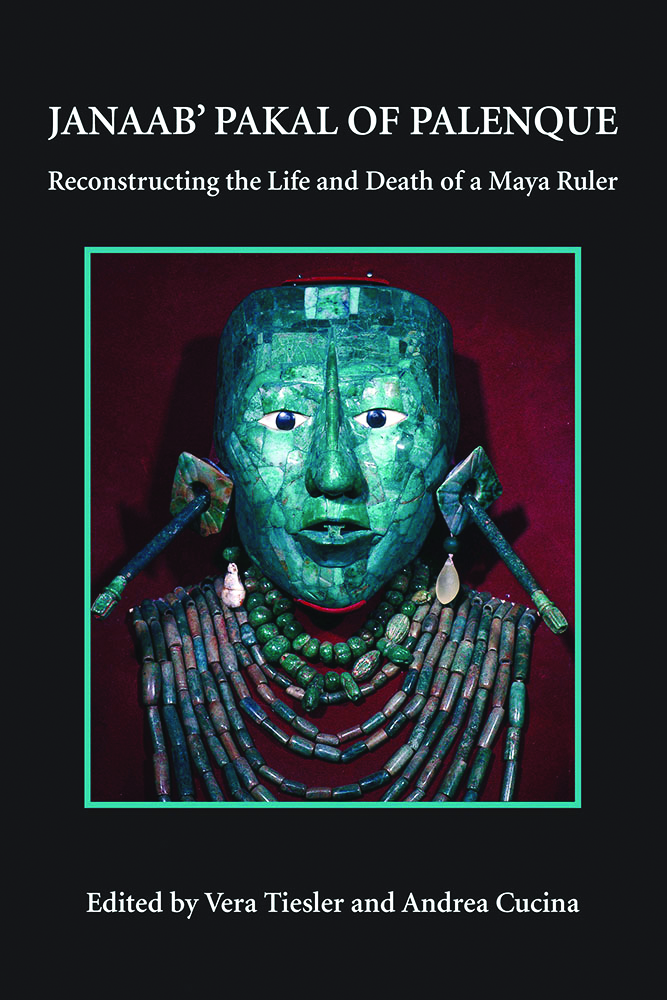Janaab' Pakal of Palenque
Reconstructing the Life and Death of a Maya Ruler
Paperback ($57.00), Hardcover ($57.00), Ebook ($26.95)
Buy
Excavations of Maya burial vaults at Palenque, Mexico, half a century ago revealed what was then the most extraordinary tomb finding of the pre-Columbian world; its discovery has been crucial to an understanding of the dynastic history and ideology of the ancient Maya. Over the years, new analytical tools introduced uncertainties regarding earlier interpretations of the findings, and a reanalysis of the remains of the ruler Janaab’ Pakal using contemporary methodologies has led to new interpretations of former accounts of his life and death.
This volume communicates the broad scope of applied interdisciplinary research conducted on the Pakal remains to provide answers to old disputes over the accuracy of both skeletal and epigraphic studies, along with new questions in the field of Maya dynastic research. Contributions by scholars in epigraphy, anthropology, and bioarchaeology bring to light new evidence regarding the ruler’s age, clarify his medical history and the identification of the remains found with him, reevaluate his role in life, and offer modern insights into ritual and sacrificial practices associated with Pakal.
The book leads readers through the history of Pakal’s discovery, skeletal analysis, and interpretation of Maya biographies, and also devotes considerable attention to the tomb of the “Red Queen” discovered at the site. Findings from the new Transition Analysis aging method, histomorphometric analysis, and taphonomic imagery are presented to shed new light on the perplexing question of Pakal’s age at death. Royal Maya life and death histories from the written record are also analyzed from a regional perspective to provide a broad panorama of the twisted power politics of rulers’ families and the entangled genealogies of the Maya Classic period.
A benchmark in biological anthropology, this volume reconsiders assumptions concerning the practices and lives of Maya rulers, posing the prospect that researchers too often find what they expect to find. In presenting an updated study of a well-known personage, it also offers innovative approaches to the biocultural and interdisciplinary re-creation of Maya dynastic history.
Contributors
Jesper K. Boldseh
Jane E. Buikstra
James H. Burton
Andrea Cucina
Nikolai Grube
Patricia Hernández
Lourdes Márquez
Simon Martin
George R. Milner
T. Douglas Price
Arturo Romano
Carlos Serrano
Sam D. Stout
Margaret Streeter
Vera Tiesler
John W. Verano
This volume communicates the broad scope of applied interdisciplinary research conducted on the Pakal remains to provide answers to old disputes over the accuracy of both skeletal and epigraphic studies, along with new questions in the field of Maya dynastic research. Contributions by scholars in epigraphy, anthropology, and bioarchaeology bring to light new evidence regarding the ruler’s age, clarify his medical history and the identification of the remains found with him, reevaluate his role in life, and offer modern insights into ritual and sacrificial practices associated with Pakal.
The book leads readers through the history of Pakal’s discovery, skeletal analysis, and interpretation of Maya biographies, and also devotes considerable attention to the tomb of the “Red Queen” discovered at the site. Findings from the new Transition Analysis aging method, histomorphometric analysis, and taphonomic imagery are presented to shed new light on the perplexing question of Pakal’s age at death. Royal Maya life and death histories from the written record are also analyzed from a regional perspective to provide a broad panorama of the twisted power politics of rulers’ families and the entangled genealogies of the Maya Classic period.
A benchmark in biological anthropology, this volume reconsiders assumptions concerning the practices and lives of Maya rulers, posing the prospect that researchers too often find what they expect to find. In presenting an updated study of a well-known personage, it also offers innovative approaches to the biocultural and interdisciplinary re-creation of Maya dynastic history.
Contributors
Jesper K. Boldseh
Jane E. Buikstra
James H. Burton
Andrea Cucina
Nikolai Grube
Patricia Hernández
Lourdes Márquez
Simon Martin
George R. Milner
T. Douglas Price
Arturo Romano
Carlos Serrano
Sam D. Stout
Margaret Streeter
Vera Tiesler
John W. Verano
“Presents an illuminating, synthetic perspective of Maya nobility through biological anthropology that is woven into the epigraphic and archaeological record.”—Latin American Antiquity
“Testifies to the coming-of-age of life-history approaches in bioarchaeology and serves as a showcase for advances in bioarchaeology and Maya epigraphy.”—Journal of Anthropological Research
"This book is original in its holistic, multidisciplinary approach to the analysis of a single tomb and its attention to Maya chronicles as well as to skeletal analysis. It takes the reader carefully through the history of Pakal's discovery, skeletal analysis, and interpretation of Maya biographies."—Ekaterina Pechenkina, City University of New York
"This volume is a milestone for the study of Maya skeletal remains and epigraphy and sets to rest a dispute that has challenged the accuracy of both skeletal and epigraphic studies of the ancient Maya. It should be avidly read by Maya archaeologists, osteologists, and the ever abundant avocational enthusiasts of Maya archaeology."—Lori Wright, Texas A&M University
“Testifies to the coming-of-age of life-history approaches in bioarchaeology and serves as a showcase for advances in bioarchaeology and Maya epigraphy.”—Journal of Anthropological Research
"This book is original in its holistic, multidisciplinary approach to the analysis of a single tomb and its attention to Maya chronicles as well as to skeletal analysis. It takes the reader carefully through the history of Pakal's discovery, skeletal analysis, and interpretation of Maya biographies."—Ekaterina Pechenkina, City University of New York
"This volume is a milestone for the study of Maya skeletal remains and epigraphy and sets to rest a dispute that has challenged the accuracy of both skeletal and epigraphic studies of the ancient Maya. It should be avidly read by Maya archaeologists, osteologists, and the ever abundant avocational enthusiasts of Maya archaeology."—Lori Wright, Texas A&M University
 The University of Arizona Press
The University of Arizona Press

